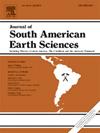Multicriteria geospatial analysis for prioritizing soil erosion risk areas in a reservoir-contributing watershed
IF 1.5
4区 地球科学
Q3 GEOSCIENCES, MULTIDISCIPLINARY
引用次数: 0
Abstract
Soil erosion is a serious threat to sustainable land use management, making the identification of erosion-prone areas increasingly important. This study aimed to identify areas with riska to soil erosion in the Piquiri River basin, a significant tributary of the Paraná River and a key contributor to the Itaipu Hydroelectric Plant reservoir. A Multi-Criteria Analysis (MCA) integrated with geospatial techniques was used to map areas most susceptible to erosion. Several factors were considered: topography, land use and cover, soil erodibility, landslide susceptibility, proximity to rivers, time of concentration, and pasture quality. The criteria were analyzed using the Analytic Hierarchy Process (AHP), which allowed for weighting the relative importance of each factor based on expert consultation. The factors were combined using two multi-criteria methods: Weighted Linear Combination (WLC) and Ordered Weighted Averaging (OWA). The maps indicated that the highest erosion risk areas are mainly concentrated in the upper and middle parts of the basin, associated with steep slopes and degraded pastures. Furthermore, it was found that regions close to rivers also presented high priority for intervention. The OWA method, by varying the level of risk and compensation, made it possible to simulate different decision-making scenarios. The methods were compared with MUSLE and similarity was verified between the priority areas estimated by multicriteria analysis and soil loss. The study concludes that multicriteria techniques, integrated with geospatial tools, are effective in identifying priority areas for intervention, supporting soil conservation and erosion mitigation actions.
水库流域土壤侵蚀危险区优先排序的多标准地理空间分析
土壤侵蚀是对可持续土地利用管理的严重威胁,因此确定易受侵蚀地区变得越来越重要。本研究旨在确定皮奎里河流域存在土壤侵蚀风险的地区,皮奎里河是帕拉纳河的重要支流,也是伊泰普水电站水库的主要贡献者。多标准分析(MCA)与地理空间技术相结合,用于绘制最易受侵蚀的地区。考虑了几个因素:地形、土地利用和覆盖、土壤可蚀性、滑坡易感性、靠近河流、集中时间和牧场质量。使用层次分析法(AHP)对标准进行分析,该方法允许在专家咨询的基础上对每个因素的相对重要性进行加权。采用加权线性组合(WLC)和有序加权平均(OWA)两种多准则方法对各因子进行组合。土壤侵蚀风险最高的地区主要集中在流域中上游,伴有陡坡和退化草场。此外,靠近河流的区域也具有较高的干预优先级。OWA方法通过改变风险和补偿水平,使模拟不同的决策情景成为可能。将这些方法与MUSLE方法进行比较,验证了多准则分析估算的优先区域与土壤流失量之间的相似性。该研究的结论是,多标准技术与地理空间工具相结合,在确定优先干预领域、支持水土保持和减缓侵蚀行动方面是有效的。
本文章由计算机程序翻译,如有差异,请以英文原文为准。
求助全文
约1分钟内获得全文
求助全文
来源期刊

Journal of South American Earth Sciences
地学-地球科学综合
CiteScore
3.70
自引率
22.20%
发文量
364
审稿时长
6-12 weeks
期刊介绍:
Papers must have a regional appeal and should present work of more than local significance. Research papers dealing with the regional geology of South American cratons and mobile belts, within the following research fields:
-Economic geology, metallogenesis and hydrocarbon genesis and reservoirs.
-Geophysics, geochemistry, volcanology, igneous and metamorphic petrology.
-Tectonics, neo- and seismotectonics and geodynamic modeling.
-Geomorphology, geological hazards, environmental geology, climate change in America and Antarctica, and soil research.
-Stratigraphy, sedimentology, structure and basin evolution.
-Paleontology, paleoecology, paleoclimatology and Quaternary geology.
New developments in already established regional projects and new initiatives dealing with the geology of the continent will be summarized and presented on a regular basis. Short notes, discussions, book reviews and conference and workshop reports will also be included when relevant.
 求助内容:
求助内容: 应助结果提醒方式:
应助结果提醒方式:


